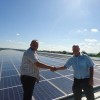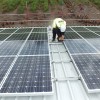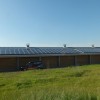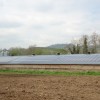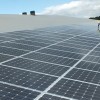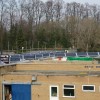Differing Forms of Silicone
The silicone crystals employed in Solar PV Cells come in differing forms of which the most common are:
Mono-Crystalline Silicon
This is the purest form of Silicone crystal in which the Valence electrons are not free to move. Impurities such as Boron and Phosphorus are deliberately introduced to improve conduction so that a current flows.
To make PV Cells, thin slices are cut from ingots onto which the essential circuitry is screened. Mono-Crystalline cells generate more power per m² than Poly Crystalline cells. They do however cost more to produce.
Poly-Crystalline Silicon
As the second most common element in the Earth’s crust, Silicon generally occurs in sand or small particulate form. However, rather like glass, it can be reduced to a molten state and cooled to form larger blocks which can then be cut into desired shapes. However this form of Silicone contains impurities (graining) that modestly inhibit the flow of electrical current. Whilst Poly-Crystalline PV Cells are less efficient generators than their Mono-Crystalline equivalents, their production costs are lower.
Amorphous Silicon – Thin Film Solar Technology
Traditionally, small, solar powered electrical devices use Thin-Film Solar Cell technology. Perhaps the size of postage stamp, these cells really are wafer thin. The cells have a light absorbing semi-conductor coating that is one millionth of a metre thick (1 micron). The coating is applied by a condensing process onto a substrate such as metal, glass or plastic.
Thin-Film Solar PV Cell modules are widely used in the hottest parts of the world. Crystalline Silicon modules do not perform well in extreme heat, as electrical resistance rises dampening the flow of current. Another attribute of Thin Film technology is that it that unlike its crystalline based counterparts, which take a while to get going, it starts working as soon as light becomes available.
Traditionally the preserve of small, low powered devices, recent Thin-Film technological advances have resulted in its broader usage. Some PV modules used in the UK now incorporate layers of Amorphous Silicone. It has been found to ease the flow of electrons out the crystalline layers, so generating some current in low light conditions when the crystalline layers are in effect ‘warming up’.
Looking into the Future - Nanosolar Technology
Encouraging advances are being made using alternative semi-conductor materials. A screen printing type process imposes layers of different semi-conductor inks onto aluminium foil. This means that light across several differing wavelengths can be used to generate electricity. Using more of the available light boosts efficiency. Manufacturing costs are theoretically much lower, but the technology is still in its infancy and has yet to move into mass market production. There is a lot of interest in it though.
For the Solar PV Investor dealing with the here and now, the financial incentives are right here and now, not way off into the future. With the passing of time the cost of solar technologies and any Government financial incentives are destined to diminish. Time may well be of the essence for the Solar PV Investor in the first half of this decade. Entry point FIT payments will gradually reduce.
Will Solar Energy Ever Take Off?
It already has!
The Cri-Cri solar aircraft may only have a limited flying time of 15 minutes and room for just one passenger - hopefully a qualified pilot with a good watch – but it certainly flies!
Remember, technology advances in small steps - unmanned solar flying machines can already stay aloft for more than 24 hours. Small, chargeable batteries are housed within wide glider style wings to provide power for flying at night.





